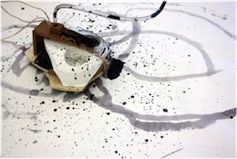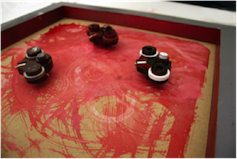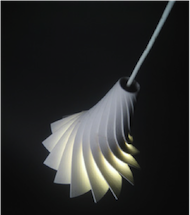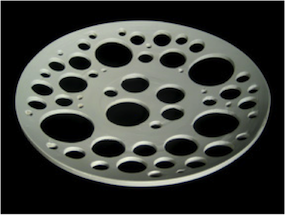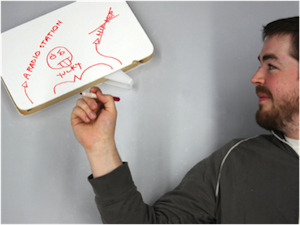A number of years ago, the design team at GE Appliances showed me a collection of sculptural objects they had recently constructed during an afternoon work session. As explained to me by Marc Hottenroth, leader of industrial design operations at GE, these sculptures made from steel, wood, wire, and found/repurposed components were material studies used to spark new ideas and reinvigorate the activities of the design team. Each object raised questions and elicited a rich dialog among the designers who were using experimentation as a means to discover new possibilities rather than validating existing ideas and honing concepts.
I was a bit surprised that professional designers would continue to engage in such “academic” endeavors. What I was most impressed with was that experimentation was embedded into the design culture at GE and the designers were using these activities to ask, “What if?” After all, this is what we’re taught to do in design school—to play with “stuff” to discover potential without immediate application. But what function does experimentation like this serve in professional practice today?
Experimentation can lead to discoveries, new conclusions, and serendipitous innovation. Historically, experimentation has been a hallmark for designers, demonstrating creativity, astute inquiry, and a synthesis of ideas and methods. Today, much of the design process is streamlined into linear practice moving from research to criteria to concept generation to specification. And while we may argue that designers try new approaches and consider alternative ideas, the bold idea of purposeful play through experimentation has diminished greatly overall.
As a case in point, students entering college today prefer taking the safe road during their design process and have little or no experience working beyond a prescriptive approach. This is a quality of the “millennial” generation—today’s students who will become tomorrow’s designers. I teach at a technical university founded upon the spirit of experimentation, and the trend toward prescriptive design processes that excludes discovery I’ve observed over the past eight years is disconcerting. Design is about discovery, not merely executing a set plan.
So I pose three questions to our professional colleagues to reflect upon: Is there a role for experimentation in your design process? What relevance is there for experimentation in UX practice today? And when was the last time you simply made something to see if it could work?
The second question is key, and while I will not answer it in this article, I do want to start a conversation about the chances we take in the design process—the risk vs. reward of experimentation—and what form experimentation takes in your practice as a UX professional.
In this article I will include examples of “experiments to discover”, embodied by interactive product concepts from my course Experimental Form (Carnegie Mellon, School of Design). This course is specifically designed to encourage students to work outside of their comfort zones and requires them to experiment with materials, electronics, and computation to develop new concepts for interactive products. This is our sandbox.
I will use a few key themes to introduce the conceptual drivers for experimentation in interactive product concept exploration. While these examples and themes are situated in tangible products, the approaches and “spirit” of experimentation may be applicable to those who are concerned with digital, computational, and purely screen-based media.
Enlightened Trial and Error
The role of experimentation in design can be viewed two ways:
- As a necessary but (financially) risky activity aimed at making somewhat serendipitous breakthroughs with product concepts (discovery), but that may end up not leading anywhere.
- To demonstrate validity of a design idea or to test concepts against established metrics (testing).
The trial-and-error process of finding new ways of doing things is a necessary part of a generative design process and a vital activity in the development of engaging products. Designers concerned with interactive and experience-driven products and systems need to continually push the boundaries of conventions and establish new methods, practices, and forms. The following five themes represent some approaches for experimentation in designing interactive products.
1. Using Our Hands Before Our Eyes and Minds
Objects (products) carry meaning, elicit emotional responses, and serve utility in our daily lives. We tend to develop rich and meaningful connections with products that resonate deeply with our sense of identity and enhance our quality of life. To develop these connections and create lasting relationships with objects, we engage with products on many levels: the physical, emotional, spiritual, and intellectual.
From an industrial design perspective, the richest interaction with a product is through the physical form. Industrial designers practice a methodology of form-giving that emphasizes the physical (ergonomics). Beyond ergonomics is semantics (the meaning interpreted from visual/physical forms), a structured approach to form-giving that uses visual and physical cues to suggest interaction, functionality, etc. Squishy buttons, contour grips, and easy-to-open door handles all result from good ergonomic studies; products with these features truly fit the human body—think OXO GoodGrips.
However, developing good tactile interactive forms designed to be interacted with primarily using the hands (what industrial designers today might call “high touch”) often results from experimentation in shaping wood, plastics, and clay. Differing from form studies aimed a resolving product concepts, experimentation in this space deals with responding to the material as it is shaped rather than just exerting your will upon it. Industrial designers play with materials to make shapes, learn about material properties, and to build sensitivity to formal qualities.
Working with our hands to shape objects for our hands engrains information deep within our bones. The sensitivity gained from sanding amorphous surfaces into wood to see how light impacts the perception of form builds real understanding of physical form through the subtractive sanding process. Shaping clay into empowering grips to move beyond shapeless, squishy handles to pull edges and surfaces into tension to fit intuitively into the hand enables the designer to build a rich understanding of form using their hands as the primary receptors. This understanding cannot be replicated through photographs, videos, illustrations or words. In other words, you have to do it to know it.
A colleague of mine recounted a story about how he asked a well-known carver of decoy ducks how he knew exactly where to make all of his fine chisel cuts into the blank wood block. The man responded, “Well, I just carve away everything that isn’t a duck.”
Experiments in making interaction tangible. These studies use subtractive methods to remove material and shape found objects into delightfully interactive forms for the hand. The goal is to craft forms that invite someone to pick them up and keep them in constant motion. Shown here are a carved tagua nut (Jason Yore), a shaped wooden form (Jason May), and a shaped stone (Lauren VonDehsen). This basic experimentation leads to a richer and more intuitive understanding of working with materials and enables designers to use intimately employ visual and physical senses while shaping the form.
2. Pushing the Boundaries of Materiality
There are traditional uses for materials and nontraditional uses of materials. Sometimes working with a material outside of its expected application and context can open pathways to finding new opportunities. Working with traditional materials like wood, stone, and clay helps to build understanding of hard and soft materials; for designers, these materials are very familiar. However, when combining the traditional, basic model-making materials with more nontraditional materials such as latex, silicone, and resin, new and exciting discoveries can be made.
Working to push materials to do things that you didn’t think were possible requires some experimentation. We have to continually ask, “what can I do with this material?” and “can I make the material do what I want it to?” If Charles and Ray Eames didn’t experiment with bent plywood, the world would be a very different place.
Many times, experimentation leads to failure or a discovery of limitations and impossibilities—this is still valuable. As I tell my students, utter failure arises from half-hearted, undisciplined attempts that lead nowhere. Beautiful failure, on the other hand, is a disciplined, committed attempt that may fail in delivering the intended results, but leads to discovery, knowledge, and encourages reflection.
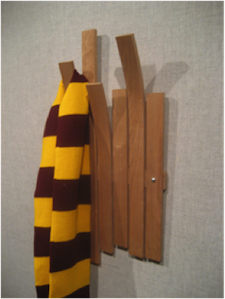
3. Embracing the Unknown
During the design process, there are always unknowns. Information, external forces, events, and situations regarding product concepts, client needs, market trends, etc. can fluctuate significantly and somewhat randomly. We try in vain to predict these fluctuations to stay ahead of radical shifts so we can keep our design process on track and profitable.
What if we look at an unknown as an opportunity? Let’s set aside for a moment the notions of budgets, timelines, deliverables, and contracts, and consider unknowns to be catalysts for discovering new opportunities—a typical R&D approach. When I was a kid, I used to read “Choose Your Own Adventure” books, in which the reader is confronted with choices at key moments in the story that shape the story and outcome, and require jumping forward or backwards in the book. Sometimes you made a choice and the story would end right there; other times, the story continued in an unexpected fashion and truly became an adventure. I tend to view experimentation as an adventure story and don’t mind jumping in to a problem and sorting out the details along the way.
Again, suspend the pressures of professional design and consider the rich dialog that can develop between you and the subject. If you embrace the idea of unknown forces (issues) arising, you learn to be resourceful and adaptive. It is during these challenges that we sometimes are most inventive. Apparent failures in a design process, along with the uncertainty and the “throw-away” material, are fodder for innovation beyond the narrow constraints of what was thought to be the project scope.
One assignment I’ve given students in the past pushed them into the deep end and forced them to manage a variety of technical, logistical, and interaction issues. This project, called the kinetic visualizer, dealt with both embedded electronics and mechanics. Students had to create a simple machine that makes art—in other words, something that a person can set into motion that will move/behave and record its movement onto a substrate (usually paper). Although the project was challenging, it creates a playful engagement with technology and materials to make a form that can behave in ways to have repeatable results. Students learn that designing with technology can lead to more expressive forms, ones that suggest what they do and visually engage the audience. No more boxes. We need to move beyond the screen and beyond the clamshell enclosure.
Lucas Martin used speaker vibration to propel ink and to move the contraption across a page to leave a Jackson Pollack-like trail that visually depicts the music it plays; Christian Park integrated vibro-motors and magnets to move and repel objects as they trail paint.
Jason May embedded gearing and a motor into this wooden form to drag a pencil lead. View on Vimeo.
Josh Finkle used halogen bulbs to “draw” lines and effects on thermal paper – unrolled, these look like silhouetted landscapes. View on Vimeo.
4. Purposeful Play
Rapid prototyping and CAD modeling are great tools to specify and detail a design concept. Powder-based printers, fused deposition modeling technology, and stereolithography machines can build up forms quickly for verification. These advanced design tools be used to experiment with form. Designers can use computer-controlled machining processes to build forms that push these tools to deliver forms that may seem to be beyond their limitations. This practice of experimentation enables designers to move beyond traditional “woodshop” modeling into a realm where computation becomes the medium to work with.
Rapid prototyping enables freedom to fail with low investment of time and money. By pushing the limits of each machine, these tools become no longer just a means to an end, but rather tools that will inform and shape the experimental design process.
Michael Levy pushed Solidworks/CAD modeling and a Z-Corp printer to their limits when designing this plaster lamp. The complex curvature was achieved by lofting and off setting curves. Michael printed this form multiple times with subtle variation in efforts to achieve a solid print that would not collapse under its own weight, would be robust enough to endure hand finishing, and be able to mount with electrical components. Lee Byron used Processing, an open source programming language and environment, (processing.org) to plot various arrays of scattered and scaled circles from which he drilled this hole pattern for this fruit platter.
5. Challenging Conventions to Develop New Paradigms
When it comes to designing interactive products with embedded electronics, it is sometimes difficult to wrestle technology with form generation. We constantly try to achieve objects that are useful, usable, and desirable (from Liz Sanders’ Converging Perspectives: Product Development Research for the 1990s). But it is most exciting when we develop something novel like a feature or a behavior that we can integrate into the form. Sometimes this feature can become the driving concept behind product interaction.
Can we continually challenge conventions and develop new paradigms of interaction without experimenting?
I believe that we must take the “mundane” out of everyday products, raise expectations, and push boundaries with form to test learning curves and challenge ourselves to design products that resonate with people in deep, meaningful ways. But we can’t achieve this if we’re completely conscious and prescriptive with our designing. We must sometimes give ourselves over to the process and see where it leads.
Another assignments I gave my students was the “Re-Reouted Radio” project, which involved students in designing new paradigms for interactive objects. Each student played with radio components, rewired existing radios, and some integrated computation to develop new sequences, movements and behaviors. Rather than starting with firm concepts, students explored materials and electronics to develop ideas and to resolve their forms. Collectively, their processes were not linear; rather, they were encouraged to meander to arrive at solutions informed by discoveries along the way.
Radio prototypes: Cheng Xu’s thought bubble that you can use to mark your favorite stations and select station by moving the angle wedge; and Jeremy Wolf’s radio hidden within a stack of books, requiring alignment of the books to change the radio station and opening the top book to adjust volume.
Kuan-Ju Wu’s plant silhouette form that uses sensors and gravity switches for discrete controls. View on Vimeo.
Jason Yore’s conical form that integrates functionality into a dynamic form. View on Vimeo.
Summary: The Spirit of Experimentation
With an open mind and a willingness to explore pathways that may lead to dead ends, experimentation can be exciting and rewarding. Cooperative experimentation for design teams enables designers to exercise their minds and hands in ways beyond their daily routines and, most importantly, it sparks conversation. Individual experiments enable designers to play, ask questions, and arrive at solutions at their own pace.
If our minds aren’t challenged in new ways, we lose the ability to think creatively. This is the greatest fear of designers—that designing becomes a job in which we just show up, execute the expected, and collect a paycheck. That’s not what motivates designers today. We don’t become designers to have safe, predictable, stable careers and engage in safe, predictable design processes. We thrive on challenges and have to feel that we were challenged to explore various dimensions of a design problem.
This behavior is good for the health of the team, and great for the longevity of the designer—this is good for the soul. Every professional office needs a sandbox.
The more experimentation we can do to complement our established skills and methods, the healthier the profession will be and the more rewarding the act of designing may be. So, how do you currently integrate experimentation and purposeful play into your professional design practice? What shape does experimentation take for UX?



